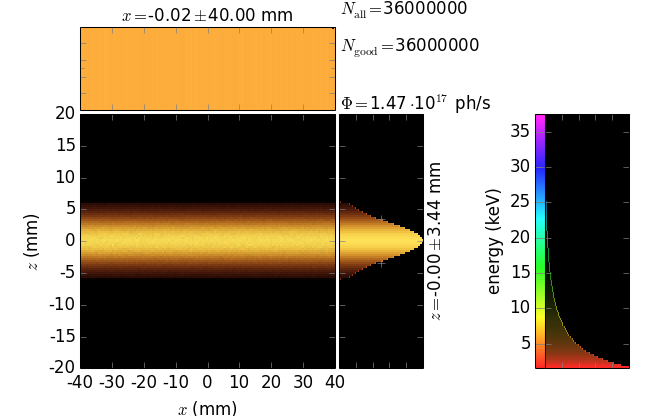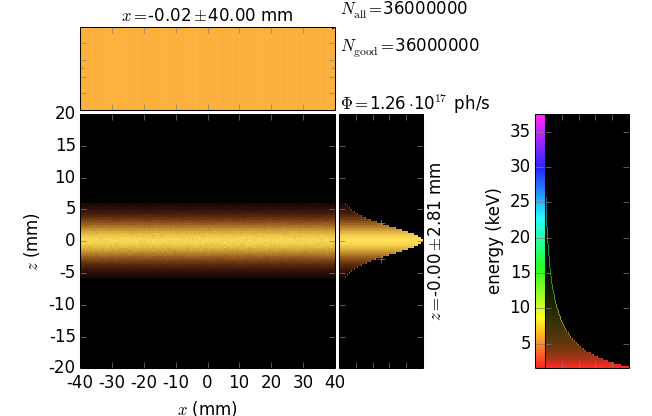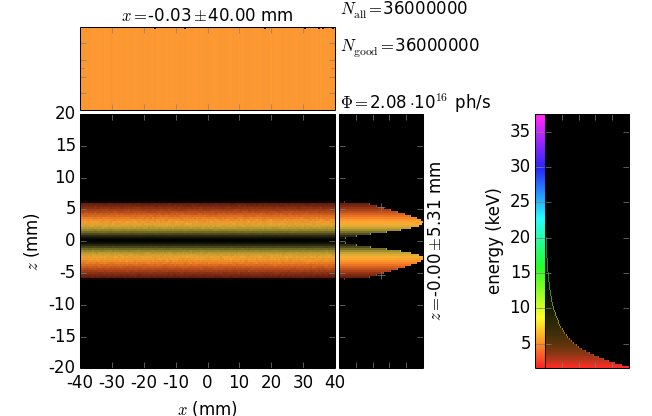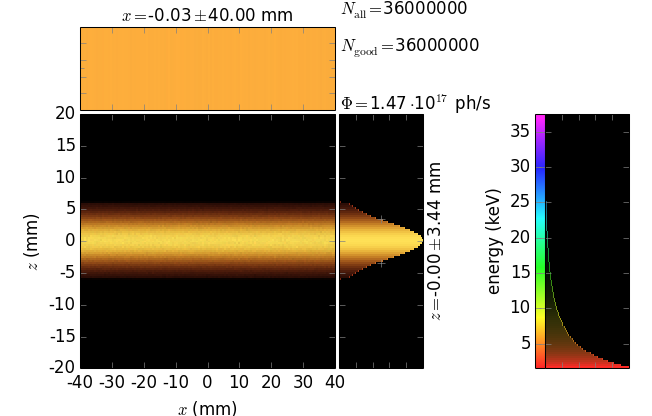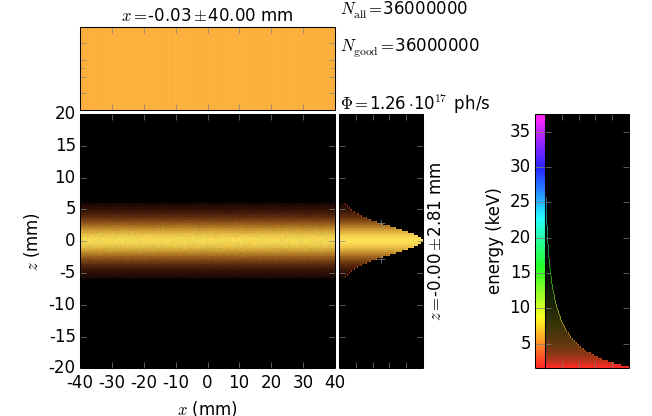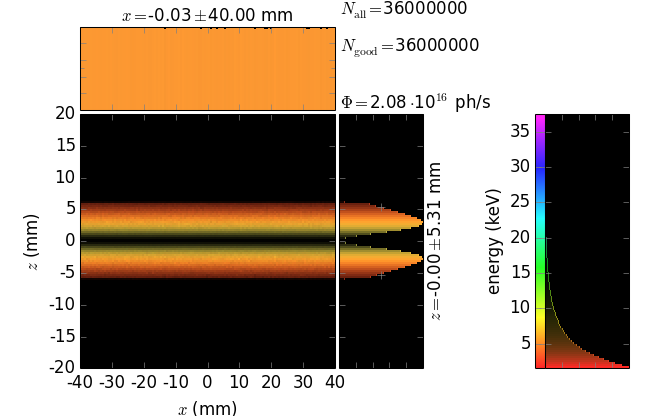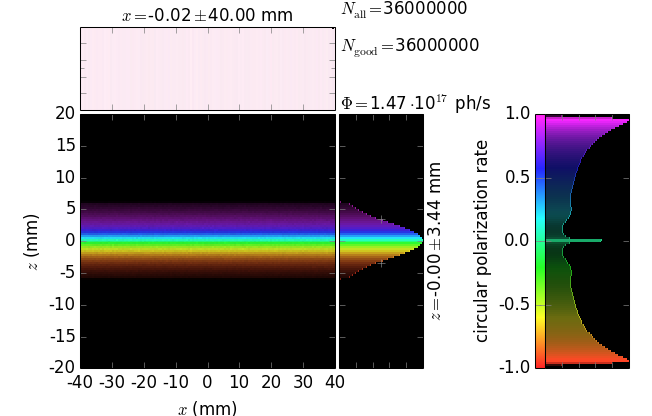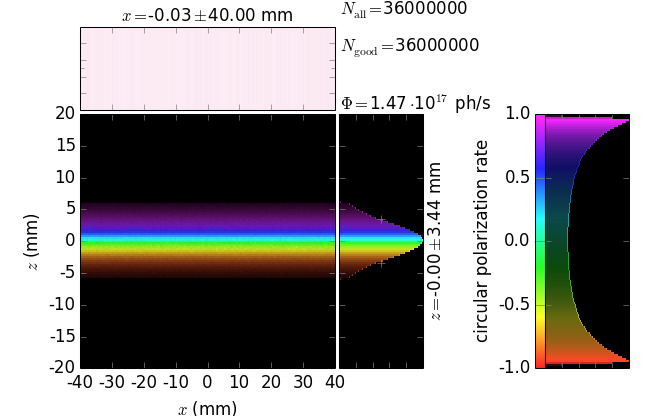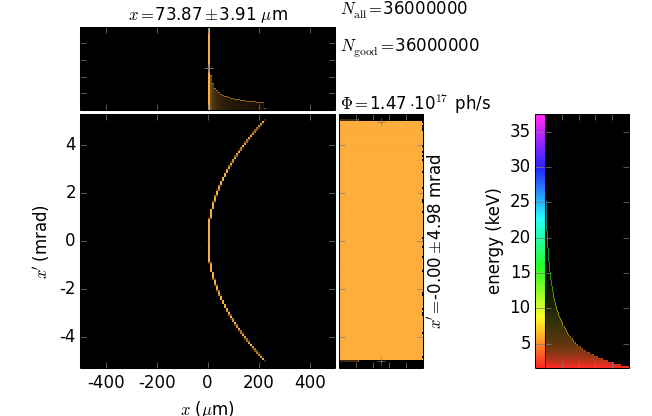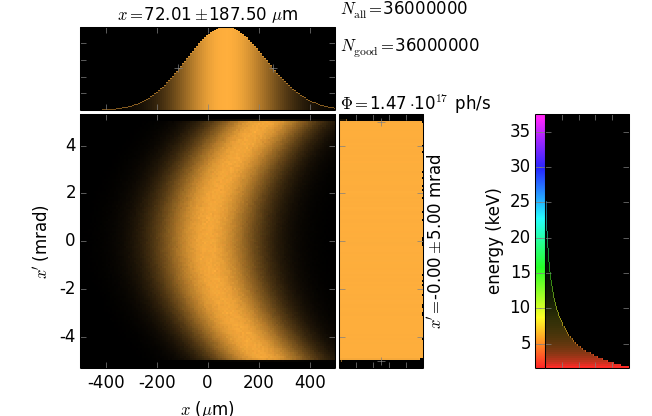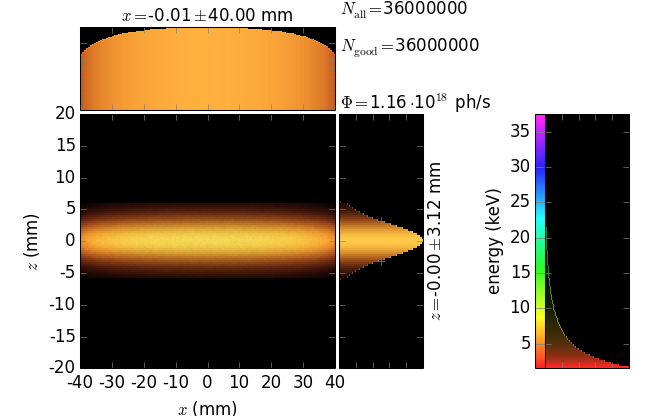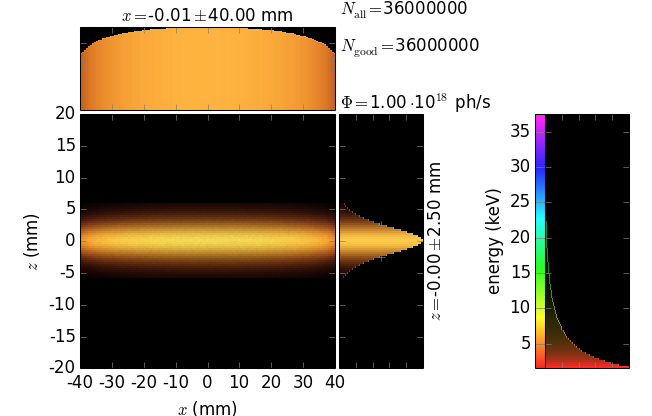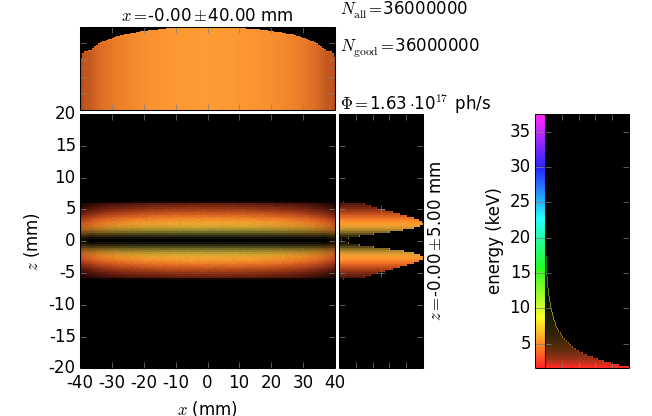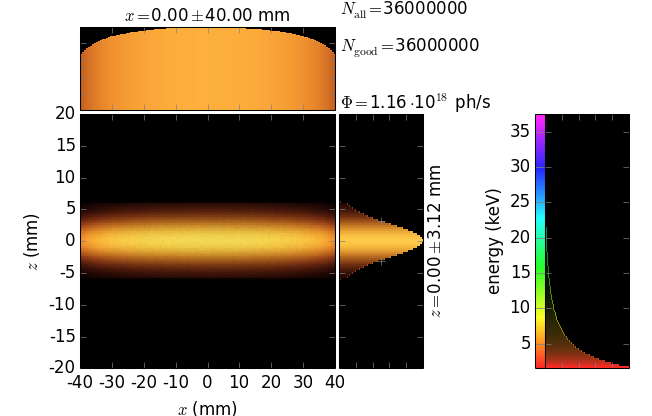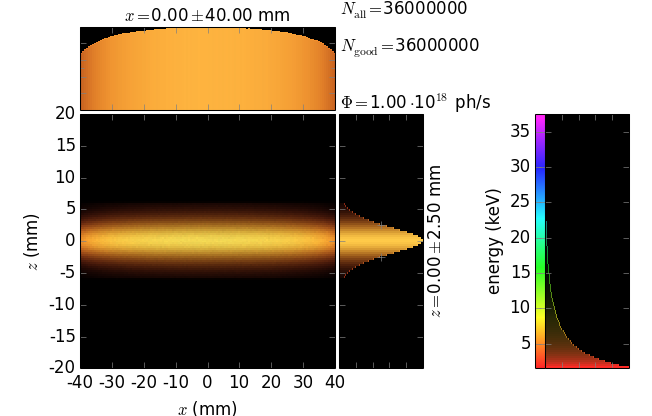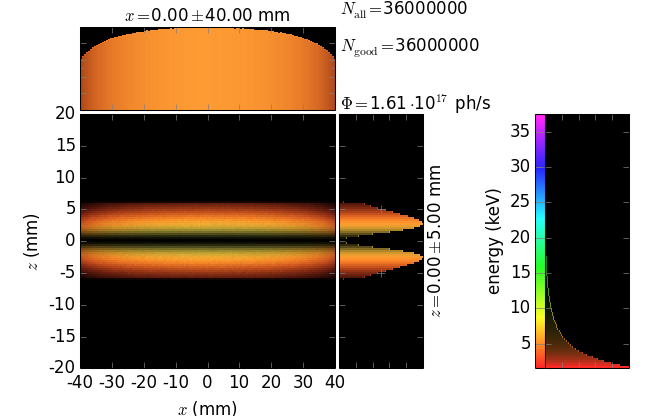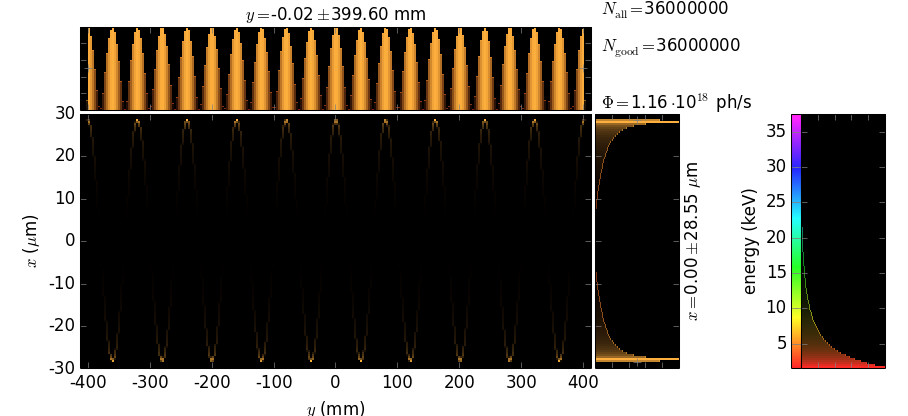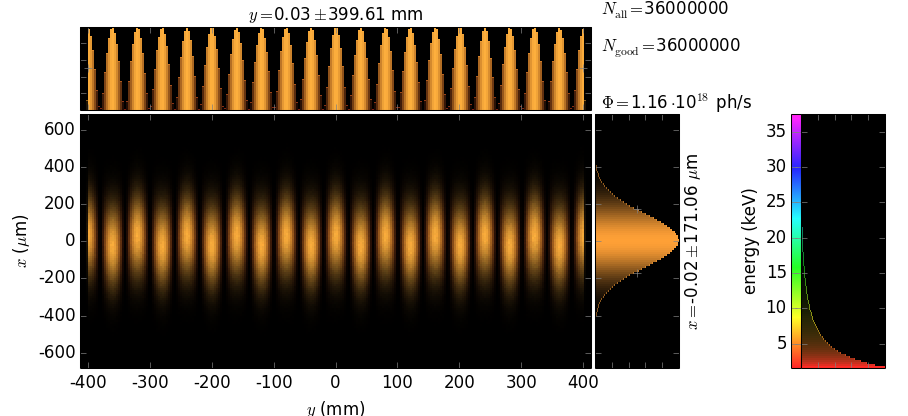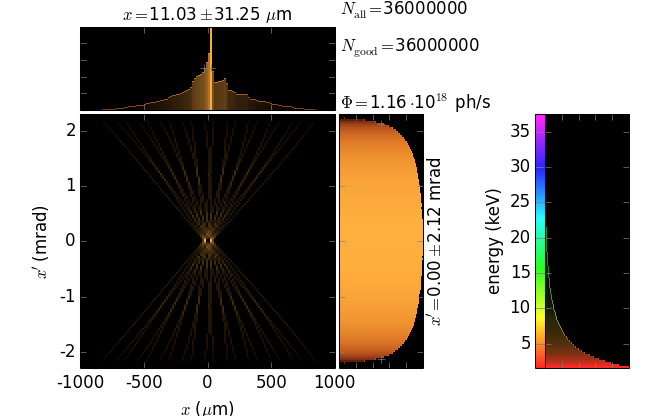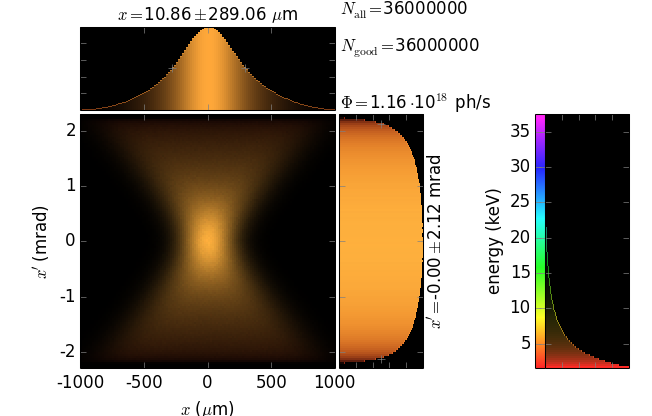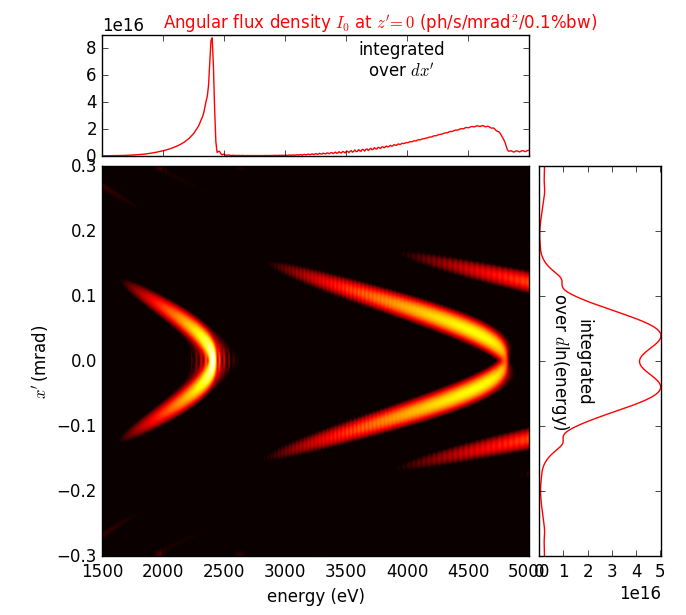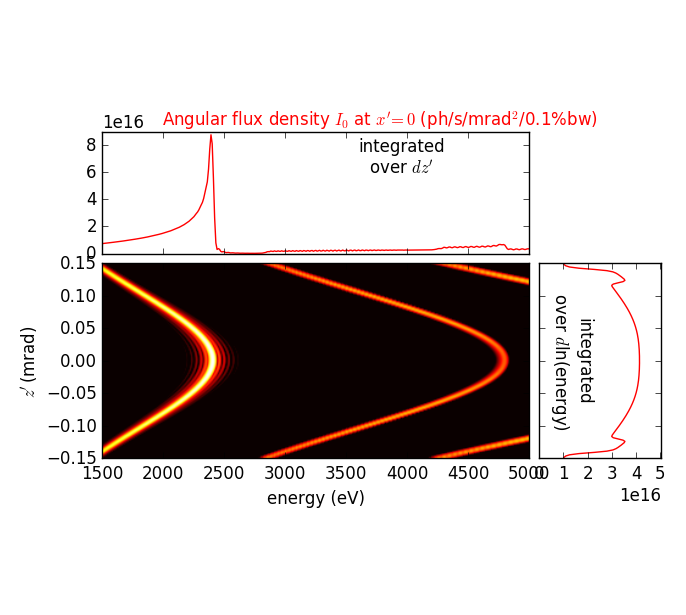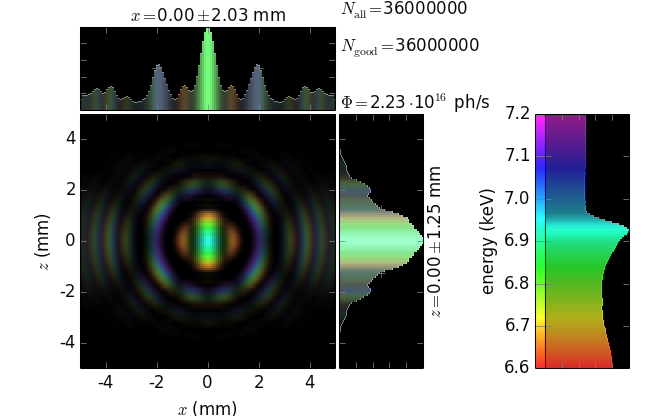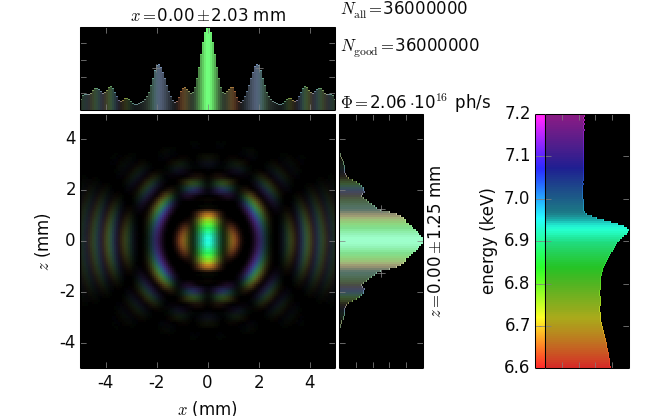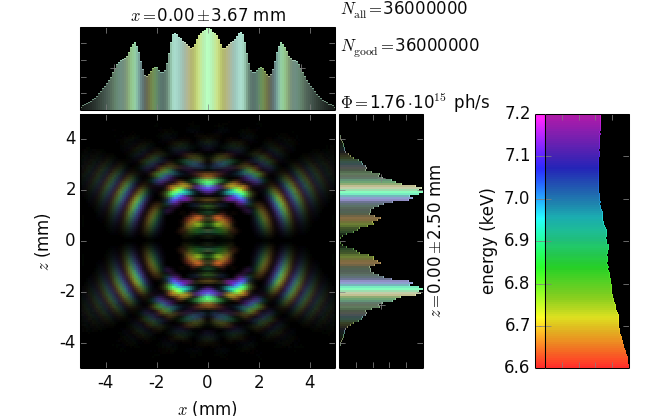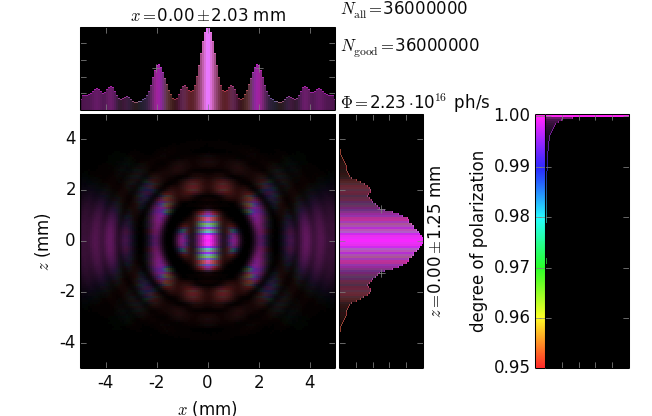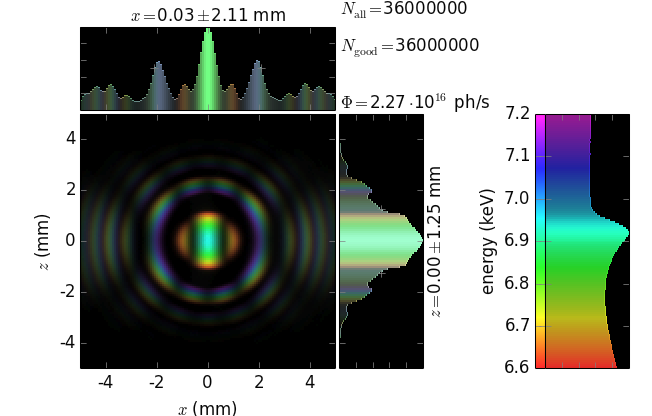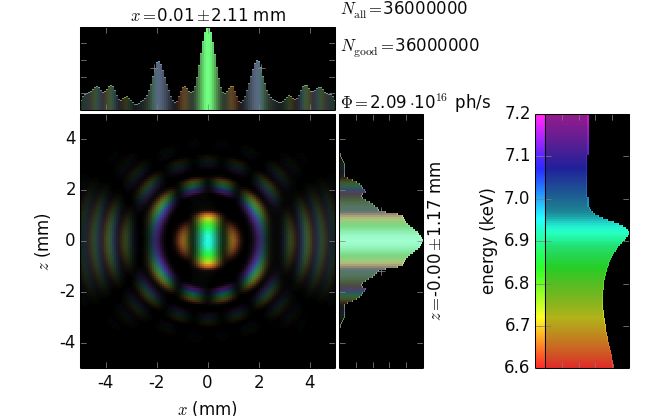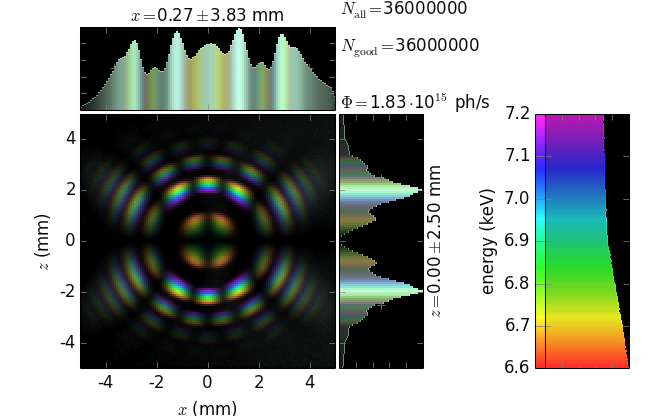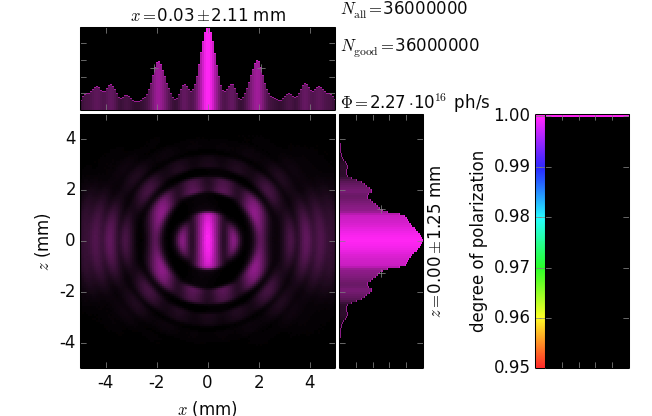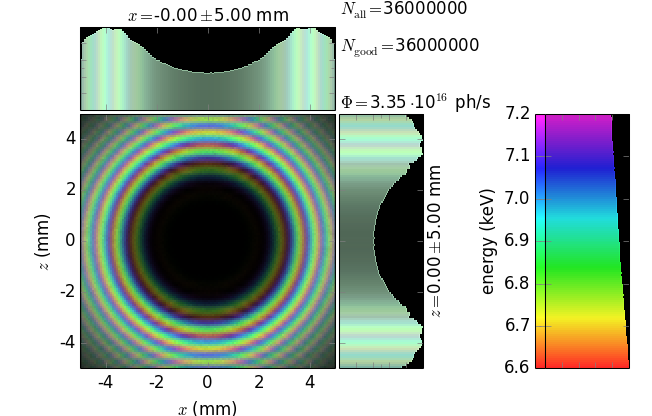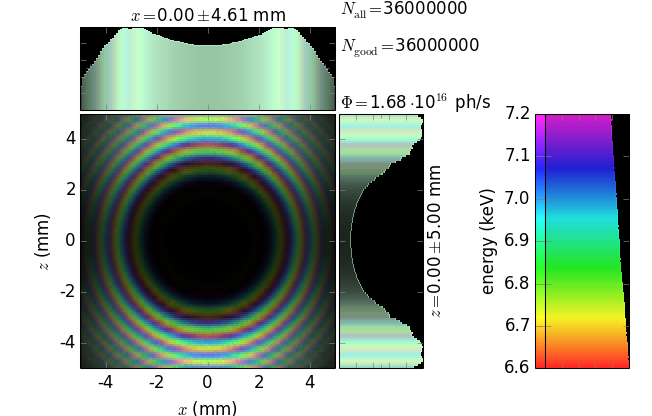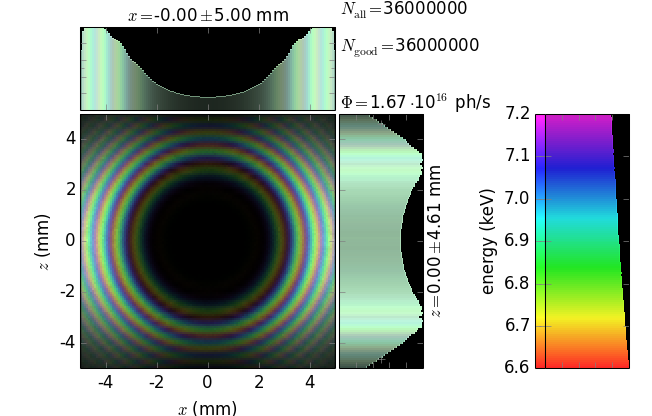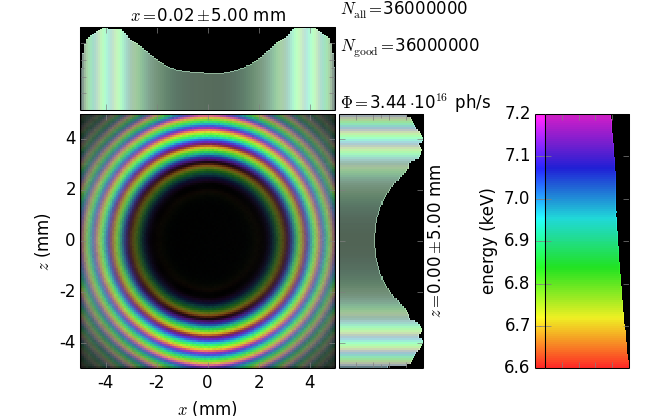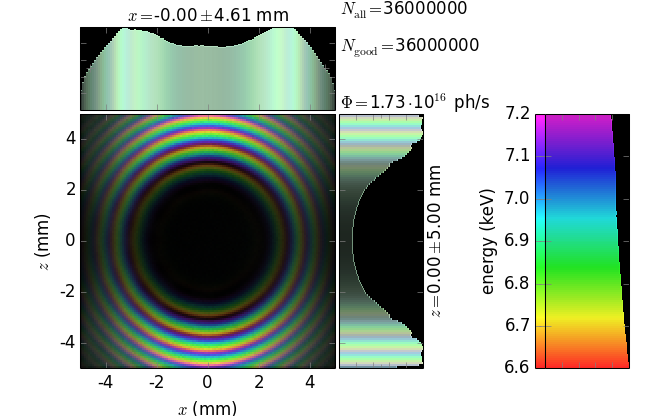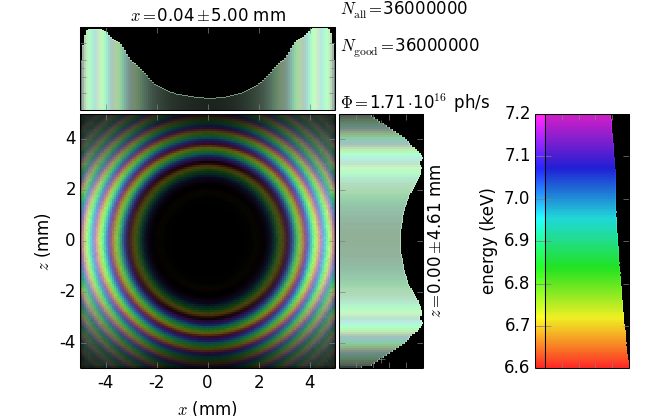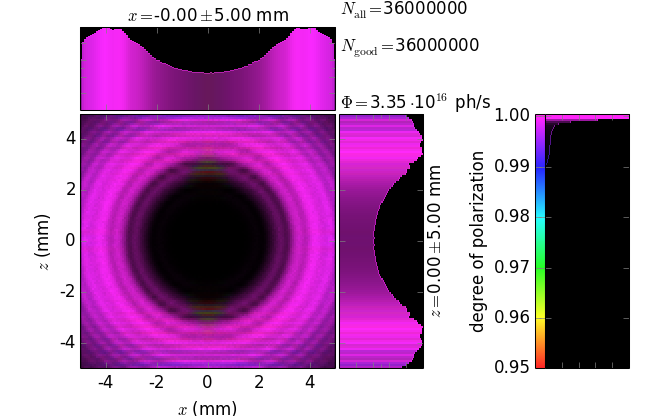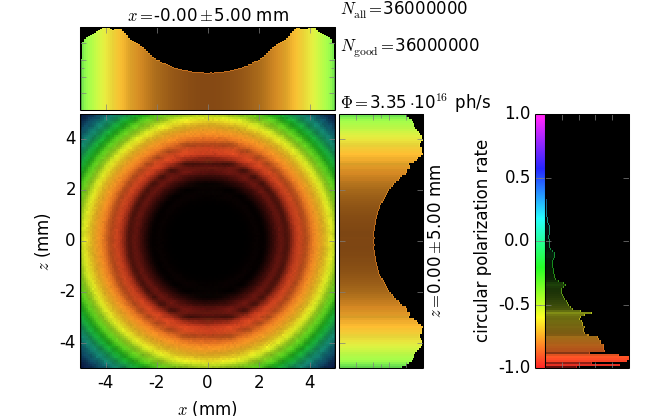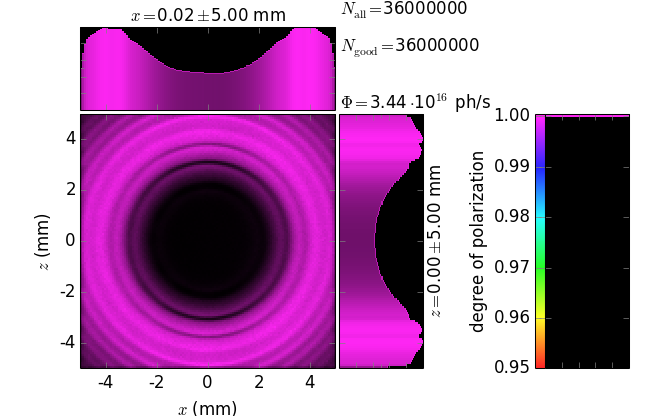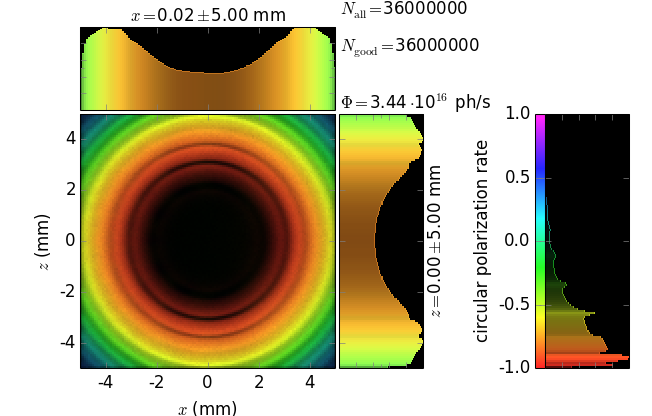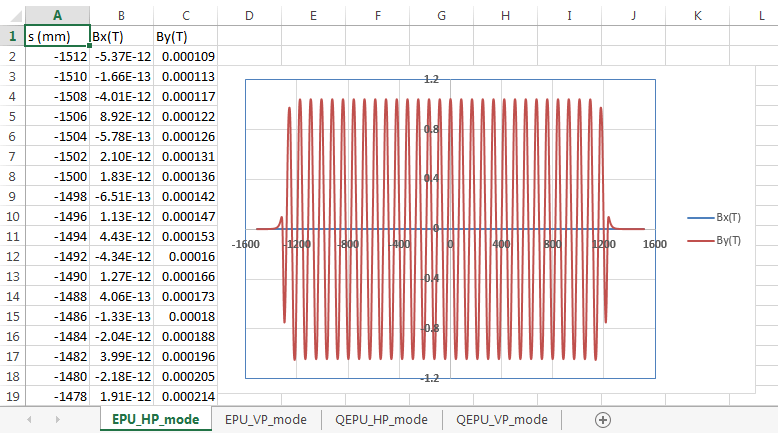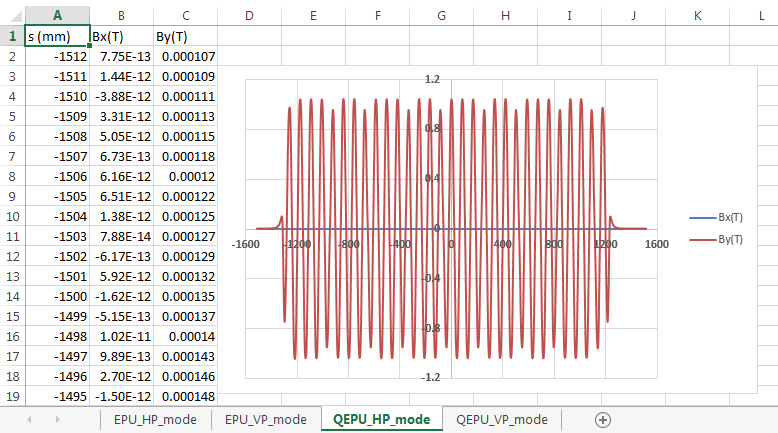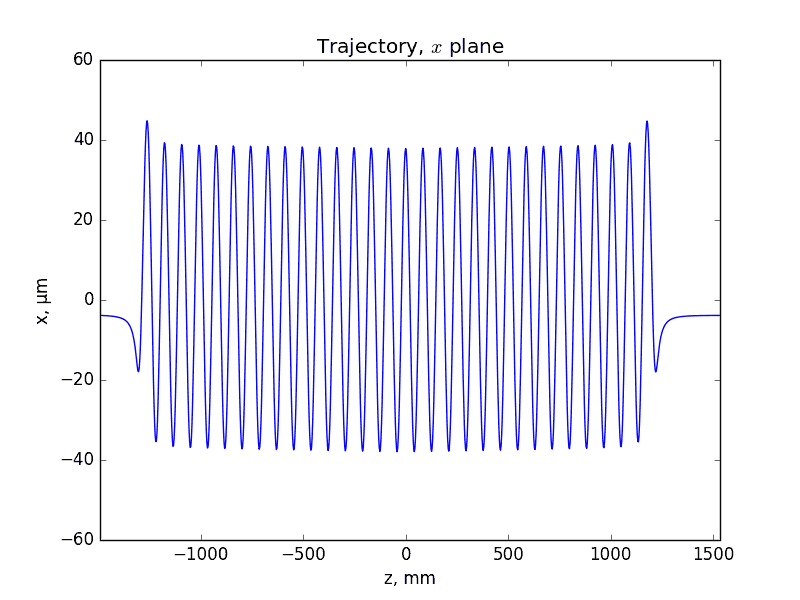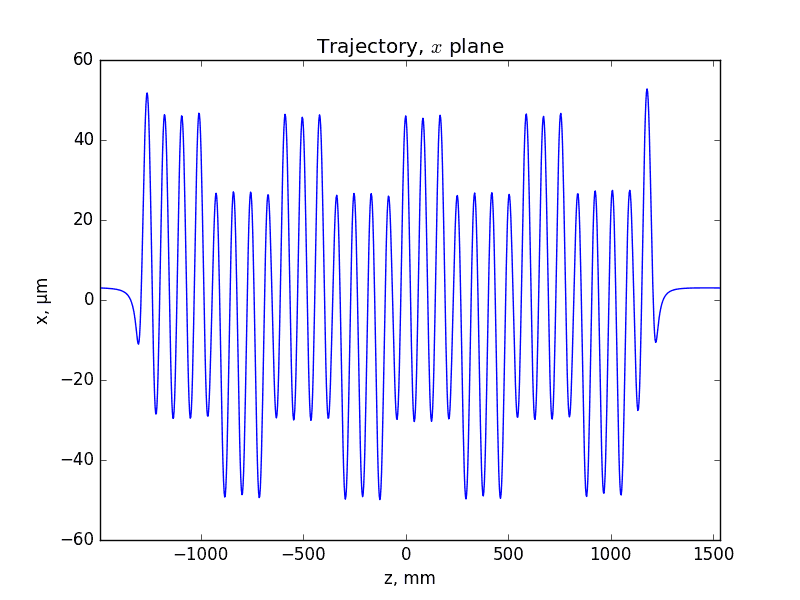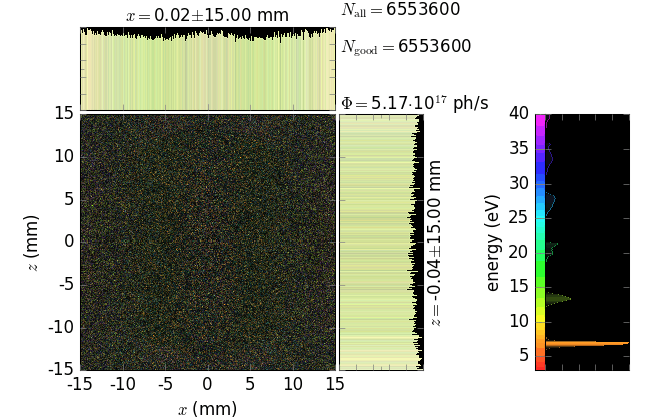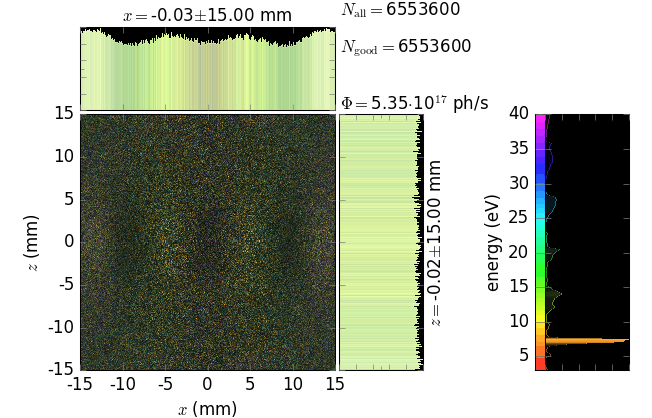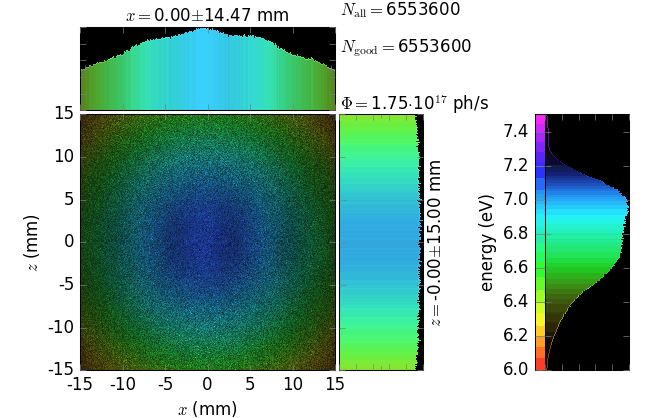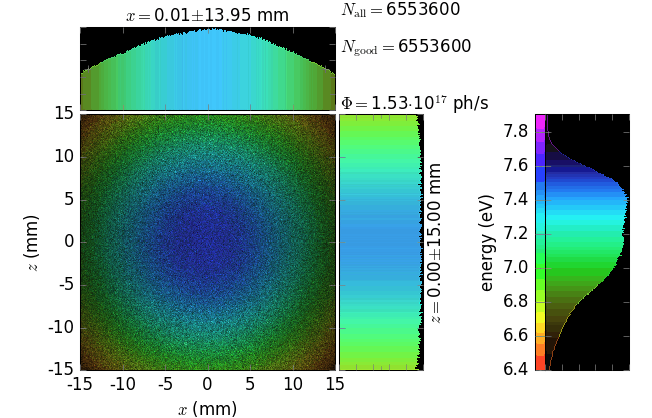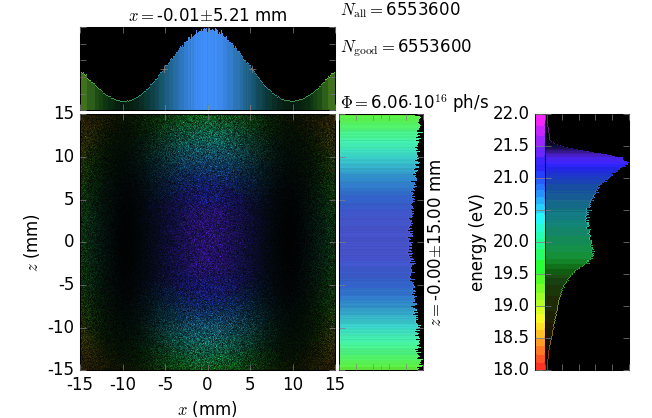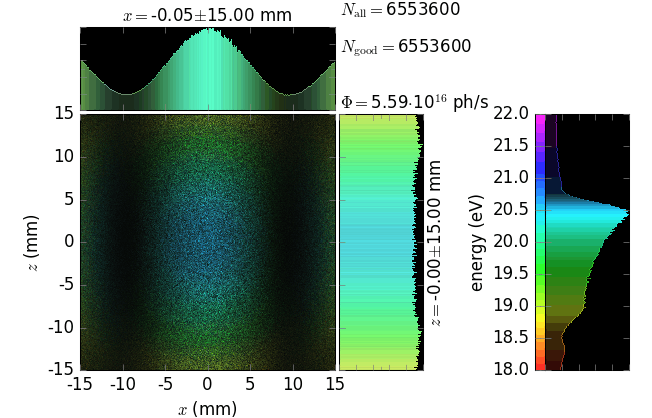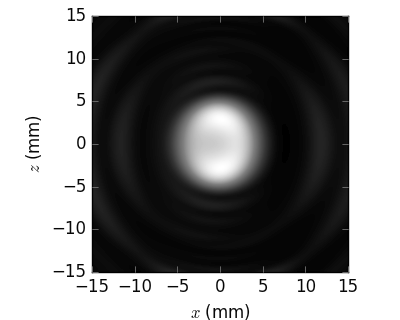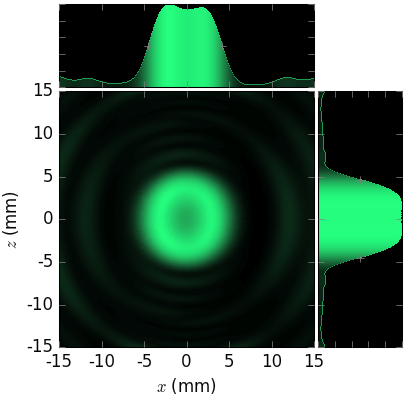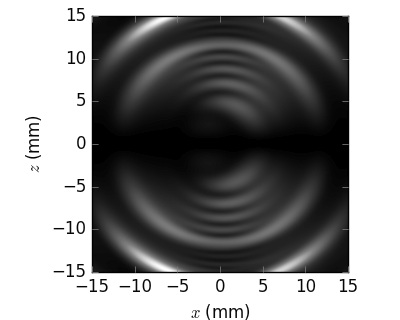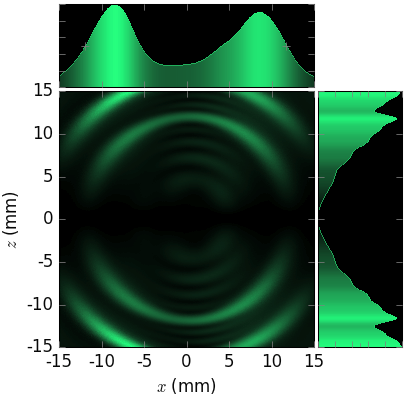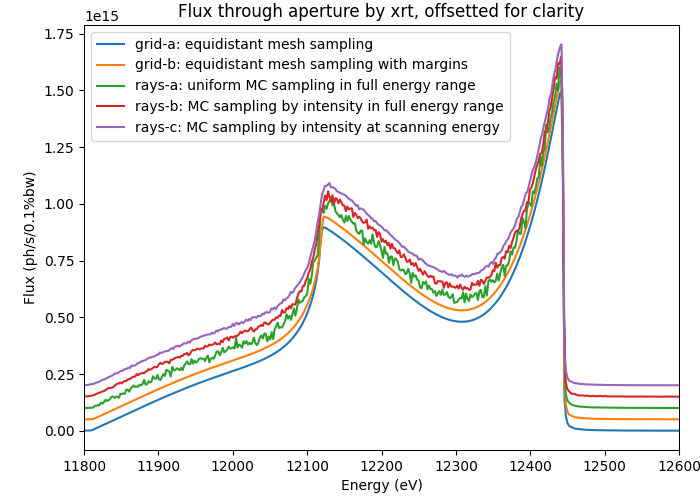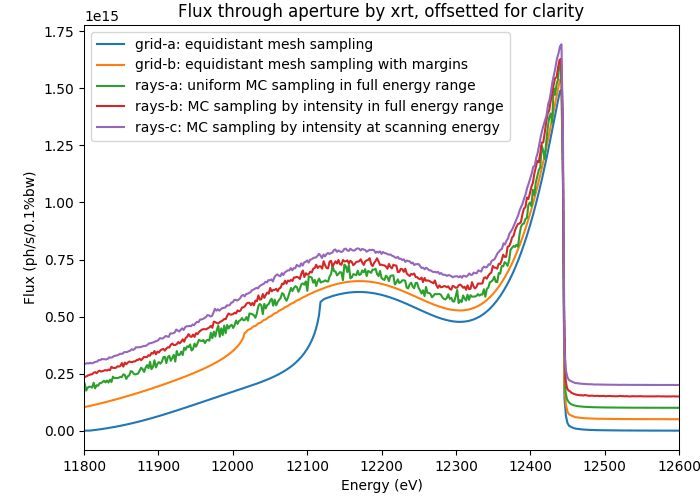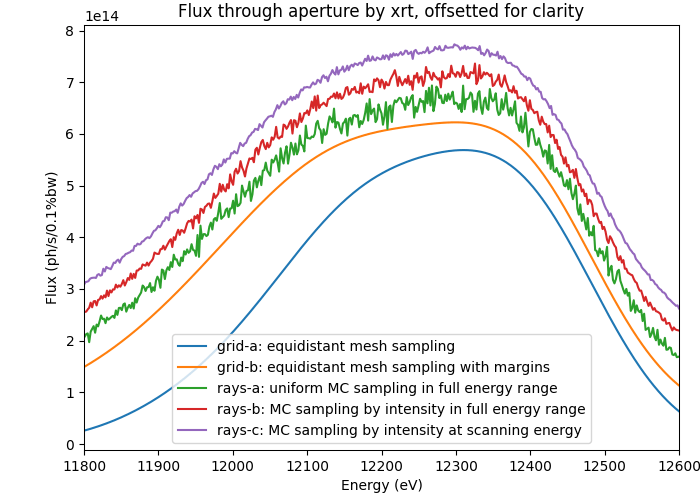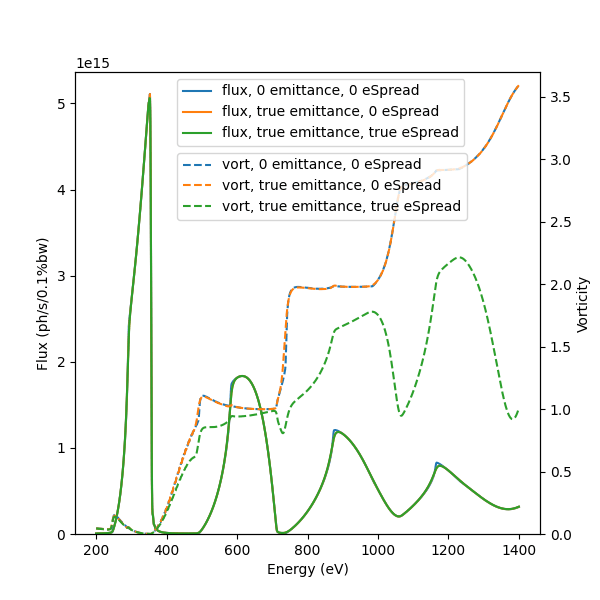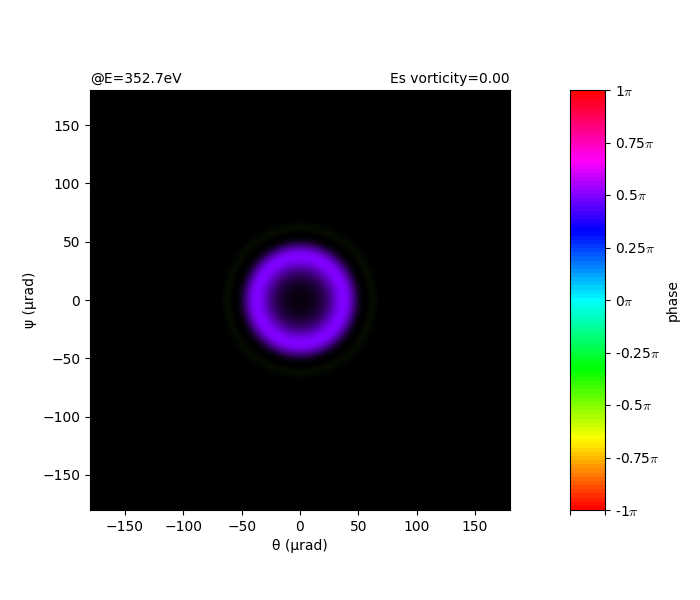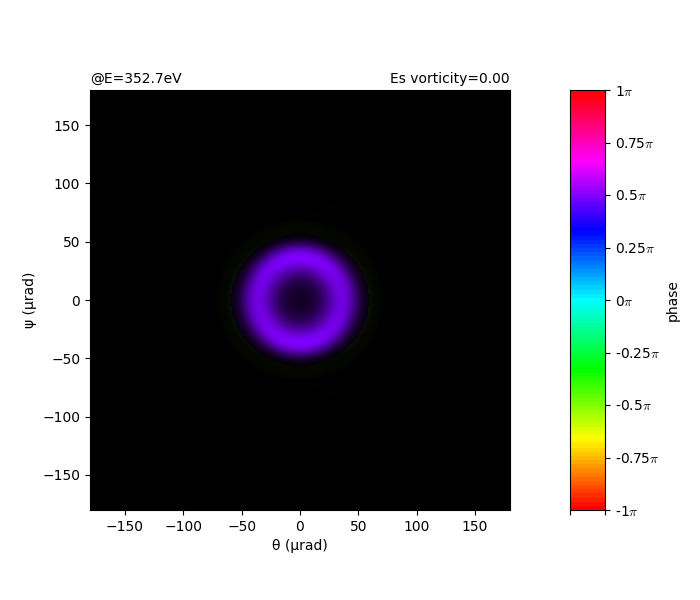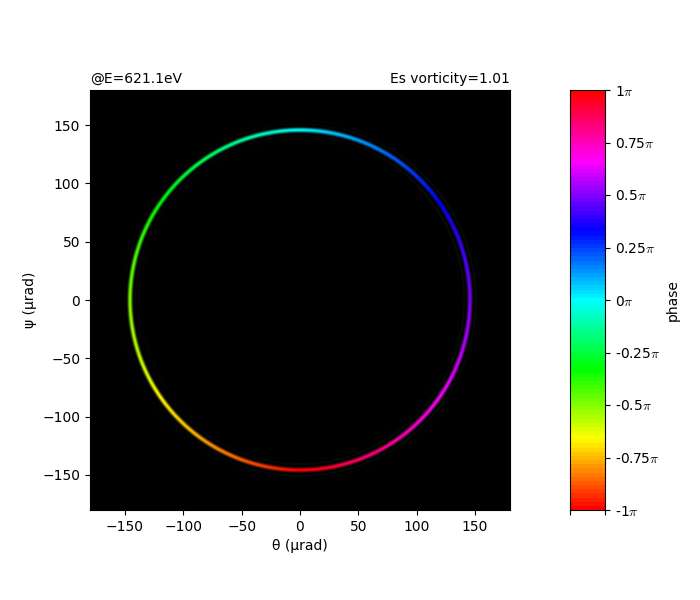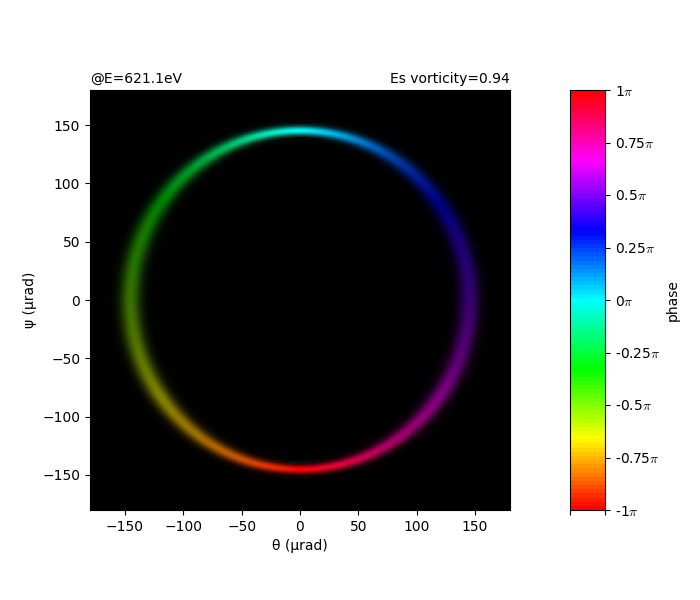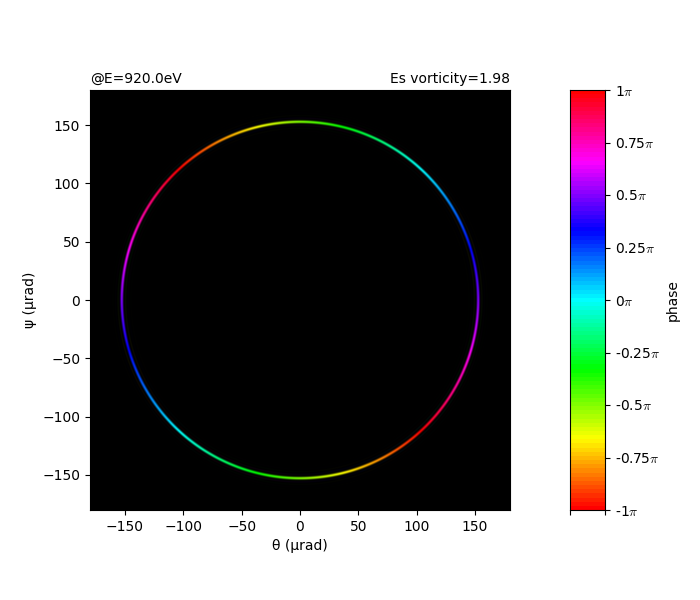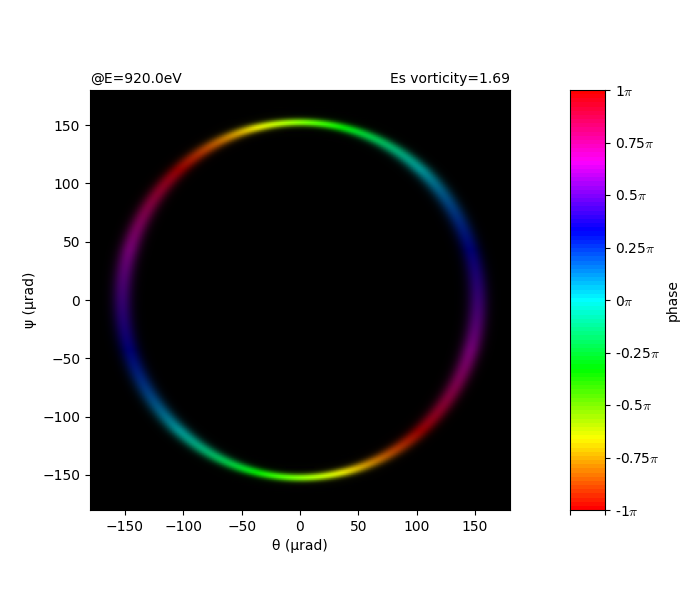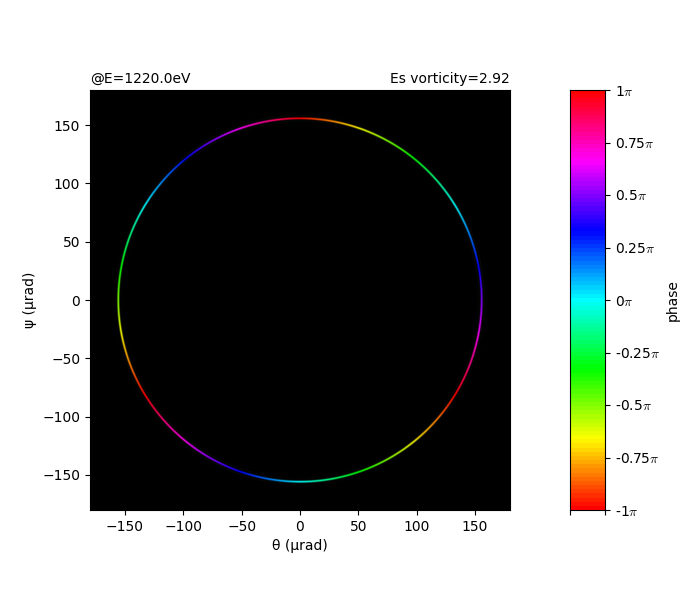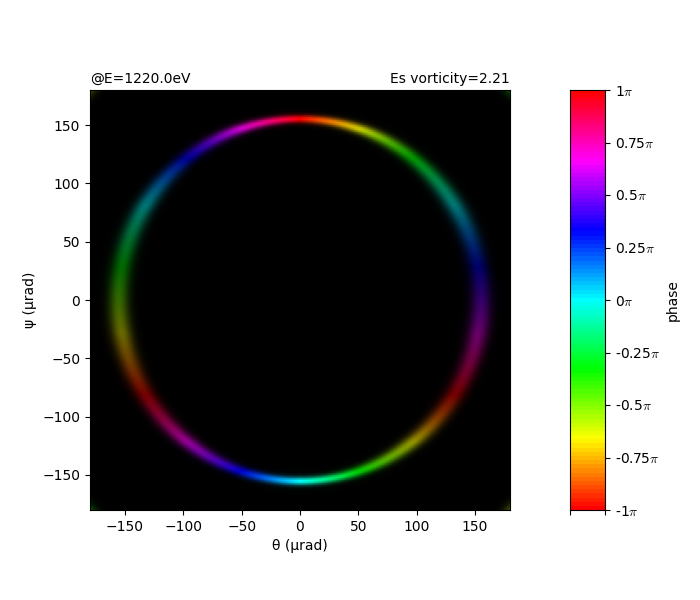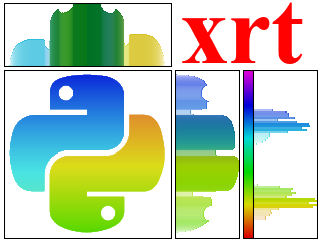Gallery of plots and scripts 1. Synchrotron sources¶
Synchrotron sources¶
The images below are produced by
\tests\raycing\test_sources.py and by
\examples\withRaycing\01_SynchrotronSources\synchrotronSources.py.
Bending magnet¶
On a transversal screen the image is unlimited horizontally (practically limited by the front end). The energy distribution is red-shifted for off-plane photons. The polarization is primarily horizontal. The off-plane radiation has non-zero projection to the vertical polarization plane.
source |
total flux |
horiz. pol. flux |
vert. pol. flux |
|---|---|---|---|
using WS |
|||
internal xrt |
The off-plane radiation is in fact left and right polarized:
source |
circular polarization rate |
|---|---|
using WS |
|
internal xrt |
The horizontal phase space projected to a transversal plane at the origin is parabolic:
zero electron beam size |
σx = 49 µm |
|---|---|
Multipole wiggler¶
The horizontal image size is determined by the parameter K. The energy distribution is red-shifted for off-plane photons. The polarization is primarily horizontal. The off-plane radiation has non-zero projection to the vertical polarization plane.
source |
total flux |
horiz. pol. flux |
vert. pol. flux |
|---|---|---|---|
using WS |
|||
internal xrt |
The horizontal longitudinal cross-section reveals a sinusoidal shape of the source. The horizontal phase space projected to the transversal plane at the origin has individual branches for each pole.
zero electron beam size |
σx = 49 µm |
|---|---|
Undulator¶
The module test_sources has functions for
visualization of the angular and energy distributions of the implemented
sources in 2D and 3D. This is especially useful for undulators because they
have sharp peaks, which requires a proper selection of angular and energy
meshes.
The ray traced images of an undulator source (produced by
\examples\withRaycing\01_SynchrotronSources\synchrotronSources.py)
are feature-rich. The polarization is primarily horizontal. The off-plane
radiation has non-zero projection to the vertical polarization plane.
source |
total flux |
hor. pol. flux |
ver. pol. flux |
deg. of pol. |
|---|---|---|---|---|
using Urgent |
||||
internal xrt |
Elliptical undulator¶
An elliptical undulator gives circular images with a higher circular polarization rate in the inner rings:
source |
total flux |
hor. pol. flux |
ver. pol. flux |
|---|---|---|---|
using Urgent |
|||
internal xrt |
source |
deg. of pol. |
circular polarization rate |
|---|---|---|
using Urgent |
||
internal xrt |
Custom field undulator¶
A custom magnetic field can be specified by an Excel file or a column text file. The example below is based on a table supplied by Hamed Tarawneh [Tarawneh]. The idea of introducing quasi-periodicity is to shift the n-th harmonics down in energy relative to the exact n-fold multiple of the 1st harmonic energy. This trick eliminates higher monochromator harmonics that are situated at the exact n-fold energies, which is a safer solution compared to a gas absorption filter.
Compare the harmonic energies (half-maximum position at the higher energy side) of the 3rd harmonic with the triple energy of the 1st harmonic.
Quasi-periodic undulator field for ARPES beamline at MAX IV 1.5 GeV ring, (2016) unpublished.
Note
The definition of xyz coordinate system differs for the tabulated field and for xrt screens: z is along the beam direction in the tabulation and as a vertical axis in xrt.
periodic |
quasi-periodic |
|
|---|---|---|
tabulated field |
||
trajectory top view |
||
wide band image and spectrum |
||
1st harmonic image and spectrum |
||
3rd harmonic image and spectrum |
For validation, our calculations are compared here with those by Spectra for a particular case — quasi-periodic undulator defined by the same tabulated field, the 3rd harmonic, at E=20.5 eV. Notice again that Spectra provides either a spectrum or a transverse image while xrt can combine both by using colors and brightness. Notice also that on the following pictures the p-polarized flux is only ~3% of the total flux.
SPECTRA |
xrt |
|
|---|---|---|
total flux |
||
p-pol flux |
Undulator radiation through rectangular aperture¶
The images below are produced by
\examples\withRaycing\01_SynchrotronSources\fluxThroughAperture.py.
This example illustrates the sampling concepts explained in Section Sampling strategies.
Grid sampling comes in two flavors: with a grid exactly matching the 100×100 µrad² aperture and with the same grid plus extra 30% margins on each side. Adding margins is crucial for doing convolution with electron beam angular spread. Notice that for the sharp field distributions at zero emittance and zero energy spread, the grid has to be set with fine angular steps, otherwise the flux density spectrum gets unreal ripples. One may play with ntheta and npsi values to observe the effect.
In this particular example (MAX IV Linac), eEspread value is four times bigger than a typical value for a storage ring and so the grid here needs a bigger number of gamma (relative electron beam energy) samples to obtain a smooth spectrum. One may play with eSpreadNSamples parameter to observe the effect.
Ray tracing examples illustrate two different ways of field sampling: uniform reciprocal space sampling and sampling by intensity distribution. Energy can also be sampled variously: uniformly within a given range and on an equidistant mesh (energy scan). The latter case also delivers single energy field images, which also has some calculation overhead.
The following cases are sorted in increased complexity (and calculation time) from top to bottom.
Zero emittance, zero energy spread. Here, angular mesh has to be very dense due to very sharp field features. |
|
Non-zero emittance, zero energy spread. Here, extra margins have to be added to the angular mesh in order to be able to convolve with electron beam divergence. In this example, adding 30% margins (the orange curve) was not enough. |
|
Non-zero emittance, non-zero energy spread. Here, the number of energy spread samples has to be adjusted for a large energy spread sigma otherwise the spectrum may have false sharp peaks. |
Finally, the standard ray tracing approach (“rays-b”) should be the method of choice as it does not need any parameter adjustment (in contrast to the grid methods). For not extreme cases (not too small aperture or not to big emittance and not too big energy spread) grid methods can be most efficient but anyways need a sanity check by ray tracing.
Orbital Angular Momentum of helical undulator radiation¶
The images below are produced by
\examples\withRaycing\01_SynchrotronSources\undulatorVortex.py.
This example calculates flux and Orbital Angular Momentum (OAM) of helical undulator radiation. The calculation is done on a 3D (energy, theta, psi) or 4D (energy, theta, psi, gamma) rectangular mesh for zero and true electron beam energy spread, respectively. To calculate OAM projection along the propagation direction, we first calculate OAM intensity \(I^l_s\) for the field \(E_s\)
and similarly for the field \(E_p\). OAM intensity is an incoherent distribution, similarly to the “usual” intensity, as the phase information is lost in it, and therefore it is suitable for incoherent accumulation of fields originated from different electrons distributed within emittance and energy spread distributions. After averaging intensity and OAM intensity over electron beam energy spread distribution and convolving with electron beam angular distributions, we obtain vorticity – the averaged normalized OAM value:
and similarly for the field \(E_p\).
The images below were calculated at the maximum flux energies at the 1st to 4th harmonics. As a reminder, the flux is maximized at energies slightly below the formal harmonic energies; at these energies the transverse distribution is of a donut shape. As a second reminder, the radiation from a helical undulator has only the first harmonic on the undulator axis but also has higher harmonics at finite observation angles.
The coloring of the transverse images is done by field phase. For this purpose, the radiation field (here, \(E_s\)) was coherently averaged over electron beam energy spread distribution and electron beam angular distributions. This operation is physically illegal but was used here only for the visual effect. The measurable values – intensity, flux and vorticity – were determined by the correct incoherent averaging. The image brightness represents intensity.
zero emittance, zero energy spread |
true emittance, true energy spread |
|
|---|---|---|
Flux and vorticity |
||
1st harmonic |
||
2nd harmonic |
||
3rd harmonic |
||
4th harmonic |
||
As expected, vorticity approximately equals the harmonic number minus one in the perfect case of zero emittance and zero energy spread. This pattern is quite strongly affected by electron beam energy spread. Emittance plays a much lesser role as the used angular acceptance is much bigger than the electron beam angular distributions (360 µrad vs 5.8 and 2.0 µrad rms).
